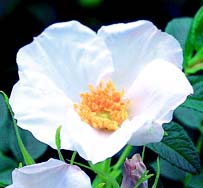Wild Rose
A tea made of the petals of this plant is said to induce dreams of one's future mate, and perhaps this is what made some people connect this magick herb with Moon. However, this pink-flowered rose is also considered the combination of red (feminine) and white (masculine) roses, a kind of summation of both, so this flower would be good for work invoking completion or unity. This is of course a traditional herb for love magick, and this wild version might be a good choice for an especially risky (thorny) or passionate relationship. Traditionally, rose petals strewn on the bed aid love spells.
 This wild rose originated in Siberia and the Far
East (the Japanese made a delicate yellow silk dye from the roots) and
came to Europe in 1796. It is one of the few roses that blooms more
than once a season. This is no gutless florist rose--it has a very
sweet, old-fashioned fragrance and is quite spiny, another example of
Venus toughness. Indeed, Venus
indulges in a bit of Mars
protection with this prickly plant, because it makes a great hedge for
keeping out snoopers, or plant it under a window to deter burglars.
Spines also keep rabbits from eating the bark in the winter. It gets
nice big hips, up to 1" in diameter, and has more flesh per fruit than
most hips. Birds love them. Hips contain lots of vitamin C and in this
species, essential fatty acids. Be careful when eating the fruits not
to eat the seeds, because they have hairs on them that can irritate the
stomach. The petals are good on butter sandwiches if you cut off their
white tips, they make a good tea for hangovers or indigestion, and they
can be put into sugar to give it a rose flavor. In winter this shrub is
quite bare and its prickles make it look like it belongs in the yard of
the Addams family. This plant gets 4-6 ft tall and just as wide. It is
hardy to the far north (zone 2, -40 F/C). This plant is also known as
wrinkle-leaf rose, saltspray rose, beach tornado, Japanese, Sitka,
Hedgehog, and Turkestan rose. Top
This wild rose originated in Siberia and the Far
East (the Japanese made a delicate yellow silk dye from the roots) and
came to Europe in 1796. It is one of the few roses that blooms more
than once a season. This is no gutless florist rose--it has a very
sweet, old-fashioned fragrance and is quite spiny, another example of
Venus toughness. Indeed, Venus
indulges in a bit of Mars
protection with this prickly plant, because it makes a great hedge for
keeping out snoopers, or plant it under a window to deter burglars.
Spines also keep rabbits from eating the bark in the winter. It gets
nice big hips, up to 1" in diameter, and has more flesh per fruit than
most hips. Birds love them. Hips contain lots of vitamin C and in this
species, essential fatty acids. Be careful when eating the fruits not
to eat the seeds, because they have hairs on them that can irritate the
stomach. The petals are good on butter sandwiches if you cut off their
white tips, they make a good tea for hangovers or indigestion, and they
can be put into sugar to give it a rose flavor. In winter this shrub is
quite bare and its prickles make it look like it belongs in the yard of
the Addams family. This plant gets 4-6 ft tall and just as wide. It is
hardy to the far north (zone 2, -40 F/C). This plant is also known as
wrinkle-leaf rose, saltspray rose, beach tornado, Japanese, Sitka,
Hedgehog, and Turkestan rose. Top
How to grow wild rose: These seeds are tough to germinate. The easiest
way to germinate them is to plant them in a pot outside in the fall.
Just barely cover with soil, and then cover with a screen or something
else that light and rain can get through but not mice or birds. They
will germinate in the spring. Or try outdoor treatment.
Or scarify the seeds by rubbing them between sheets of sandpaper and
soak them for 48 hours in hot water, changing for fresh hot water every
12 hours (use a small thermos). They are meant to pass through an
animal's gut before germination (some people use a 4-day soak in
room-temperature orange juice to simulate that--it will ferment in that
time--then wash them off). Sow in a paper towel that has been wet and
wrung out, fold, gently press together, and put in a thin plastic bag
(don't close it) and keep them in the fridge for 3-4 months, checking
regularly for germination. If they germinate first, plant right away.
Otherwise, take out and plant as usual to germinate at cool room
temperatures in 21-90 days. Or sow on Winter Solstice (see special directions on the
Solstice Sowing page). Harden off (get them used to sun and
fresh air gradually) and transplant to full sun. It will grow pretty
much anywhere except soggy soil and will even grow by the beach. Once
it gets established, you can get many more rose bushes by allowing it
to produce suckers (baby plants that grow up from the roots) or just
take a cutting 6-8"/15-20cm, dip in rooting hormone, and stick in sand.
Garlic planted near this bush will help deter bugs and disease.
Don't spray chemicals on this rose, because they will kill
it. Store seeds in the refrigerator. General growing info. Top
Rosa
rugosa
Red Wild Rose Red
35 seeds $3.50
Rosa
rugosa
Pink Wild Rose
35 seeds $3.50
Rosa
rugosa
White Wild Rose
35 seeds $3.50
Uses in Witchcraft & Magic:
Dreamwork
Love Magick
Venus/Moon Herb
© 2006-2024 Alchemy Works; No reproduction without permission